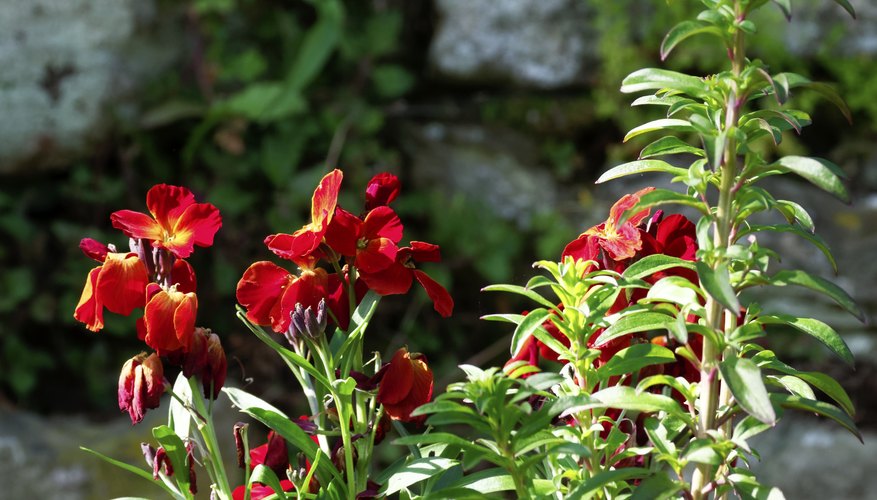A short-lived perennial that develops somewhat woody stem bases, stock (Matthiola incana) bears clusters of flowers that release a sweet clove fragrance. Stock blooms in cool weather, but persists as a leafy plant when temperatures are too hot or cold. Modern varieties of stock derive from various interbreeding among the species Matthiola incana, M. odorata and M. sinuata. Gardeners usually grow stock as annuals or biennials, as the need for cool temperatures makes short-term culture the easiest and most reliable way to obtain the attractive flowers. Stock is native to the coastal areas from Spain to Egypt.
Types
Horticulturists tend to group stock into four varieties. Brompton types grow as two-year biennial plants and produce tall plants with upright cluster spikes of single or double form flowers. East Lothian stocks are smaller with more compact flower spikes and grow as either biennials or spring annuals. Ten Week stocks are grown as fast-growing cool-season annuals that are either tall or short in stature. Column stock refers to cultivars that grow tall with narrow, unbranching flower spikes, making them ideal cut flowers for production in fields or greenhouses. Stock cultivars often are sold and marketed as series, with similar stature cultivars grouped with an array of flower colours. Names of stock series include "Cinderella," "Giant Imperial," "Harmony," "Vegmo" and "Cheerful."
- Horticulturists tend to group stock into four varieties.
- Ten Week stocks are grown as fast-growing cool-season annuals that are either tall or short in stature.
Flowering features
Stock, whether grown as a perennial, biennial or annual flower, needs cool temperatures to yield flowers. Temperatures in the range of 10 to 21.1 degrees Celsius (50 to 70 degrees Fahrenheit) help seeds germinate and promotes good leafy growth and upright flower clusters. The plants endure light frosts, but subfreezing temperatures halt growth, cause some dieback and make plants remain unusually short before flowering. Conversely, temperatures above 26.7 degrees Celcius (80 degrees Fahrenheit) create a condition called blinding. The overly warm conditions create upright stems or spikes without any flowers, followed by plant decline.
- Stock, whether grown as a perennial, biennial or annual flower, needs cool temperatures to yield flowers.
- The plants endure light frosts, but subfreezing temperatures halt growth, cause some dieback and make plants remain unusually short before flowering.
Regional considerations
Stock can persist as a perennial outdoors in the garden throughout the British Isles. However, the plants falter when temperatures get too hot in summer, or in regions where there are more than 120 days of temperatures at or above 30 degrees Celsius occur. In hot summer regions, stock is planted in autumn or winter so it blooms in the cool weeks of spring. In the UK, stock will bloom throughout summer if temperatures don't get too warm.
- Stock can persist as a perennial outdoors in the garden throughout the British Isles.
- In the UK, stock will bloom throughout summer if temperatures don't get too warm.
Growing stock
Sow seeds or transplant seedlings of stock in a garden bed that gets full to partial sun. The soil needs to be moist, well-drained and rich in organic matter. In hot climates, start perennial and biennial plants from seed in summer to grow and flower in the winter and spring months the following year. Annual stock is easily grown when sowed indoors in containers six to eight weeks before the last spring frost date and later transplanted outdoors. To prolong the supply of flowers, sow annual stock in two-week increments so some plants grow into the flowering stage during the months when temperatures remain above 1.66 degrees Celsius (35 degrees Fahrenheit) at night but below 29.44 degrees Celsius (85 degrees Fahrenheit) during the day.
- Sow seeds or transplant seedlings of stock in a garden bed that gets full to partial sun.
- In hot climates, start perennial and biennial plants from seed in summer to grow and flower in the winter and spring months the following year.
